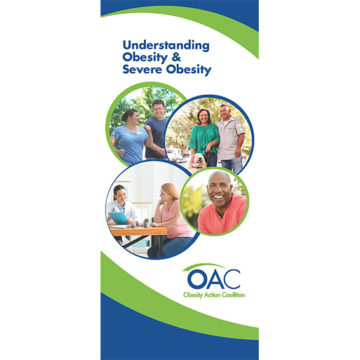Understanding Childhood Obesity Brochure


Childhood obesity is often misunderstood. Simplistic views on this very complicated issue can make addressing childhood obesity, just like adult obesity, challenging. This brochure aims to provide a science-based understanding of childhood obesity that is focused on evidence, not stigma and shame.
What is Childhood Obesity?
Childhood obesity affects one in five children, making it the most common chronic disease of childhood. Like in adults, obesity in children is a chronic disease characterized by excess or abnormal body fat impacting health.
Today, more and more children are being diagnosed with diabetes, hypertension and other conditions associated with carrying excess weight or obesity. Contributors to childhood obesity are often complex, involving genetic, environmental and behavioral factors. Oftentimes, the exact cause of childhood obesity is unclear in individual children.
A child should be screened for obesity by a qualified healthcare provider if their body mass index-for-age (or BMI-for-age) percentile is greater than 95%. A child should be screened for excess weight if their BMI-for-age percentile is greater than 85% and less than 95%.
Contributors to Childhood Obesity
Genetics likely make some children more susceptible than others to environmental and behavioral factors that contribute to obesity. While they are too numerous to list here, certain factors are targeted as major contributors to childhood obesity, including the following:
- Environment
- Dietary Patterns
- Lack of physical activity
- Heredity and family
- Socioeconomic status
Environment
Environment plays a major role in shaping the habits and health of children and adolescents. The prevalence of television commercials promoting unhealthy foods and eating habits is a large contributor. In addition, children are surrounded by environmental influences that dismiss the importance of physical activity.
Food away-from-home accounted for 54.8% of total food spending in 2019. This includes restaurants, cafeterias, sporting events, etc. In addition, portion sizes increase when people eat out because they tend to eat a larger quantity of food (calories) than when they eat at home.
Sugary drinks (any beverages that contain added caloric sweeteners) are the single largest source of calories in children’s diets and account for nearly half of kids’ added sugar intake. On average, kids are drinking more than 30 gallons of sugary drinks per year. These drinks, sometimes called sugar-sweetened beverages (SSB), include:
-
- Sports drinks
- Energy drinks
- Soda/Pop
- Fruit drinks
- Sweetened waters
- Sweetened coffee and tea
It is not uncommon for a 32-ounce soda to be marketed toward children, which contains approximately 400 calories and 96 grams of sugar or 24 teaspoons of sugar. The consumption of soda by children has increased throughout the last 20 years by 300%. Scientific studies have documented a 60% increased risk of obesity for every regular soda consumed per day.
Dietary Patterns
Over the past few decades, the dietary patterns of Americans have changed significantly. The average amount of calories consumed per day has dramatically increased, yet the quality of nutrients needed for a healthy diet has decreased.
Food portions also play an important role in the unhealthy dietary patterns that have evolved over time. The prevalence of “super-size” options and “all-you-can-eat” buffets create a trend in overeating. Combined with a lack of physical activity, children are consuming more food and expanding less energy.
Lack of Physical Activity
Children in today’s society show a decrease in overall physical activity. The growing use of computers, smartphones and tablets, combined with more time spent watching television and less physical education in schools, all contribute to a sedentary lifestyle in children and adolescents.
School-aged children spend most of their day in school where their only activity comes during recess or physical education classes. In the past, physical education was required on a daily basis. Currently, only 8% of elementary schools and less than 7% of middle schools and high schools have daily physical education requirements in the U.S.
Physical Activity Behaviors of Young People, According to the Centers for Disease Control and Prevention (CDC):
-
- Less than one-quarter (24%) of children six to 17 years of age participate in 60 minutes of physical activity every day.
- In 2017, only 26.1% of high school students participated in at least 60 minutes per day of physical activity on all seven days of the previous week.
- In 2017, 51.1% of high school students participated in muscle-strengthening exercises (e.g., push-ups, sit-ups, weight lifting) on three or more days during the previous week.
- In 2017, 51.7% of high school students attended physical education classes in an average week, and only 29.9% of high school students attended physical education classes daily.
Heredity and Family
Science shows that genetics play a role in childhood obesity. It has been shown that children with parents affected by obesity are more likely to be affected by obesity as well. It is estimated that 35% to 40% of a child’s weight predisposition is inherited from their parents. In some cases of childhood obesity, the genetic impact may be as high as 55% to 60%.
However, genes alone do not always dictate whether a child will have obesity. Learned behaviors, like the environment, are contributors as well. Parents, especially those whose children are at risk for obesity at a young age, should promote and model healthy food and lifestyle choices early in their development. Parents should also pay close attention to the environmental factors that contribute to obesity.
Socioeconomic Status
Children and adolescents that come from lower-income homes are at greater risk of being affected by obesity. This is a result of several factors that influence behaviors like healthy eating and physical activity. Lower-income children cannot always afford to participate in extracurricular activities, often resulting in a decrease in physical activity. Some children live in areas that are unsafe for them to be physically active outside. In addition, families who struggle with finances often opt for highly processed foods that are less nutritious because they are more affordable. However, these foods are typically higher in calories, fat and sugar. Sometimes, families don’t have access to fresh fruits and vegetables, and their only option for food close to where they live is from a convenience store. Lower-income families may also have less access to healthcare, including specific care for childhood and adolescent obesity.
Measuring Obesity in Children
Body Mass Index (BMI) is currently the most commonly used tool for measuring obesity in children and adolescents. BMI is a number calculated by dividing a person’s weight in kilograms by his or her height in meters squared.
BMI is used as a risk assessment for comorbidities/health conditions, but there are limitations. Body composition (muscle and fat mass) cannot be assessed using BMI, and may be a more important indicator for assessing obesity in individuals.
To plot your child’s BMI-for-age percentile, you must first calculate his/her BMI. Once you calculate his/her BMI, find the age of your child on the bottom of the BMI-for-age percentile chart and look to the left or right to locate their BMI. Plot the point on the graph using a pen or pencil. Once you have plotted the measurement, locate the corresponding shaded color on the bottom of the chart to determine your child’s BMI-for-age percentile.
In pediatrics, we look at the BMI percentile for a child’s age and sex. If a child’s BMI percentile is at or above the 85th percentile but less than the 95th percentile, they should be screened by a healthcare provider for overweight. If a child’s BMI percentile falls at the 95th percentile or higher, they should be screened by a healthcare provider for obesity. Children who receive a diagnosis of overweight or obesity have a higher risk of developing weight-related health conditions such as high cholesterol, high blood pressure or type 2 diabetes.
Children are growing and their bodies are changing much more rapidly than adults, so special care should be taken when interpreting BMI/weight. Clinical judgement by a healthcare provider is always important when diagnosing overweight or obesity. Parents and children should not diagnose overweight or obesity themselves.
Weight Bias and Bullying in Children and Adolescents
Unfortunately, children affected by obesity are often the victims of bullying, harassment and discrimination in school settings. Obesity stigma is the societal devaluation of a person because of their weight. Experiencing weight bias can begin at an early stage of life and can continue through adolescence. This can lead to poor mental and physical health and may even worsen obesity.
Weight bias is everywhere, including at school, at home, in doctors’ offices and in the media. In studies examining weight bias, children living with severe obesity are viewed as self-indulgent, unmotivated and lazy and are often excluded from social activities by their peers. Educators often admit to looking down upon children who are affected by obesity. There is a growing body of research examining the prevalence and the consequences of weight bias or obesity stigma, particularly in children and adolescents.
This type of bullying and weight bias can lead to:
- Anxiety
- Depression
- Disordered eating behaviors
- Poor body image
- Low self-esteem
- Substance use
- Social isolation
- Decline in health
Reducing weight bias and bullying in children has the ability to not only improve mental health, but physical health as well. There are many ways individuals, groups and society can work together to reduce stigma and bias. The OAC recognizes the need to raise awareness of weight bias, especially in children. To learn more about this serious issue and what you can do to stop it, please visit StopWeightBias.com.
Treating Childhood and Adolescent Obesity
Treating obesity in children and adolescents may require specialized care and differs from treatment in adults. Children are not small adults. Involving the family in a child’s weight management program is a key element of treatment. Treatment of childhood/adolescent obesity is not accomplished by just dieting or “eating less, moving more” as some have simplified it. Healthcare providers partner with the family to address multiple aspects of the child and the family’s lifestyle. Science-based weight management programs for children focus on providing tools to support a child in achieving the best health possible and are not about assigning blame or shaming either parents or children.
If your child is overweight or is at risk of developing obesity, it is important to work with your healthcare provider to develop an individualized plan of care that includes realistic goals and action steps. Your provider will talk with you and your child and try to help your family develop realistic and achievable goals. It will be important to check in with your provider regularly to see if there are any barriers your child is facing in meeting these goals. Parents need to provide their children with positive encouragement and support along the way. The complexity of obesity makes addressing weight very challenging, so it’s important to recognize that if your child’s current treatment isn’t working, there are other options available.
As a support system, the child’s family is essential in ensuring health goals are met. You must first assess the readiness of your child and family to make changes. If your child has signs or symptoms of depression, this needs to be addressed prior to working on your child’s weight. Unsuccessful attempts at weight-loss may worsen their depression or lower their self-esteem. In situations where there may be a significant depression or family stress, it may be most appropriate for your child and family to seek counseling to address these issues.
The various treatments for obesity in children and adolescents include:
- Behavior/lifestyle modification
- Physician-supervised options
- Surgical weight-loss options
Behavior/Lifestyle Modification
Healthy behavior and lifestyle modifications make up the foundation of obesity treatment. Lifestyles and behaviors are established at a young age. It is important for your child and the whole family to remain educated and focused on making long-term healthy lifestyle choices.
- There are several ways that your child/adolescent can modify their behavior to improve their health:
- Establishing healthier eating habits
- Increasing physical activity
- Becoming educated about the body and how to nourish it
- Engaging in a support group or extracurricular activity
- Setting realistic goals
Nutrition
When creating healthier eating habits, it is often recommended to consult with a registered dietitian (RD) who specializes in children’s needs. Dietitians can best help your child understand healthy eating habits and how to implement them in their long-term diet.
Dietitians do not always recommend restricting caloric intake for children. Nutrition counseling is based on behavior change theory and takes into consideration the whole environment, the whole person, and the child’s family. Registered dietitians may provide education on how to understand food labels and portion sizes, choose healthy food and beverage options, and modify other mealtime routines.
While there is an overwhelming amount of information on the internet and from other people, a registered dietitian will guide a patient and family through the information and help facilitate behavior change that will work for the child. A registered dietitian will help your family set realistic, achievable goals that can improve the quality of your child’s diet and their overall health.
Physical Activity
Another important part of addressing your child’s weight is physical activity. Physical activity is an important habit for children to develop, as research shows that inactivity is linked to a sedentary lifestyle in adulthood. It is worth noting that physical activity alone, without making other behavior changes, has a limited impact on weight-loss. Even with these limitations, physical activity helps improve overall health.
Increasing physical activity can decrease, or at least slow, the increase in body fat in children affected by obesity. The U.S. Surgeon General recommends children get at least 60 minutes of physical activity each day. Working with a health care professional such as a physical therapist can help you make an individualized plan that works for your child and family.
Physician-supervised Options
Working with a physician to include additional tools such as medication or surgery as part of the treatment plan is a decision that should be made as a team with the patient, family and healthcare provider. Personal preferences, family schedules and medical considerations like health conditions should all be considered. Some children/adolescents may have made significant changes to their eating habits and physical activity routines, but have not seen the desired change in their weight. They may be ready to add an obesity medication as the next level of treatment. It’s important to understand that the behavior and lifestyle changes are part of all obesity treatment plans, and as you ad medication or surgery, your child should continue to work on healthy habits.
Individual considerations are important:
-
- Your child may not want to take a medicine or may dislike how the medicine make them feel.
- Their schedule may not support using a medicine that affects their appetite (such as being unable to take it at the right time due to other commitments).
- Medical situations could be made worse with some medications, such as having high blood pressure.
- Any unwillingness from your child to make lifestyle changes would make the medicine ineffective.
In summary, if your child has health complications from excess body fat, is affected by severe obesity or is not seeing improvements in health despite great efforts, then advanced treatment tools may be considered.
Medications Approved for Children/Adolescents
Liraglutide (Saxenda)
How does it work? Liraglutide is an injectable medication approved by the FDA in 2020 for adolescents ages 12-17 with obesity. It works by targeting the appetite center of the brain, thereby decreasing hunger and food intake. Liraglutide is taken as an injection.
Weight-loss: in a study of adolescents, liraglutide was compared to a placebo for a 56-week trial. A total of 251 adolescents from ages 12-17 participated and received lifestyle treatment in the form of healthy nutrition and physical activity. Unlike adult studies, research on adolescents use different outcomes instead of weight-loss or a change in BMI. In this study, participants receiving liraglutide in addition to lifestyle treatment had a significant improvement in their weight compared to those who didn’t receive liraglutide, with very few side effects.
Concerns: The most common side effects are nausea, vomiting, diarrhea and constipation.
Orlistat (Xenical)
How does it work? Orlistat is FDA-approved for adolescents 12 years and older to help manage obesity. Orlistat inhibits the absorption of fats by 30%. It is taken orally.
Weight-loss: Adolescents who took orlistat in addition to eating fewer calories, making healthier food choices, and increasing physical activity demonstrated a 5% decrease in BMI compared to those who relied on diet alone. Adolescents taking orlistat also reduced their cholesterol and improved their glucose and insulin responses, therefore reducing their risk for type 2 diabetes.
Concerns: Orlistat can have some undesirable side effects such as oily spotting, gas and fatty/oily stools. It can also give you a sense of urgency to have a bowel movement. Lastly, since orlistat decreases the absorption of fats, it can lead to problems with absorbing vitamins that are digested with fats. In circumstances such as this, patients should be regularly monitored by a healthcare provider and consider vitamin supplements.
Phentermine (Adipex-P, Suprenza, Lomaira)
How does it work? This combination of medication was approved by the FDA in 2022 for adolescents 12 and older with obesity. Phentermine is a weight-loss drug that received FDA approval in 1959. Topiramate is traditionally used for migraine prevention and seizure prophylaxis. Together, they work by decreasing appetite and increasing feelings of fullness after eating.
Weight-loss: In a study of adolescents, phentermine-topiramate ER was compared to a placebo for a 56-week trial. A total of 223 adolescents 12-16 years of age participated and received lifestyle treatment (healthy nutrition and physical activity). Two doses were studied. Those receiving the low dose lost 4.8% of their body weight. Those receiving the high dose lost 7.1%.
Concerns: The most common side effects are dry mouth, constipation, and pins-and-needles feelings in the face, arms, hands, and feet. Insomnia may occur if taken later in the day. Phentermine-topiramate has been associated with birth defects, so contraception may be required for those of childbearing age.
Setmelanotide (IMCIVREETM)
How does it work? Setmelanotide is a daily injection given under the skin. It was approved for chronic weight management in adult and pediatric patients six years of age and older with obesity due to these genetic conditions:
-
- Proopiomelanocortin (POMC) – The neuron system that causes weight-loss. If you are deficient in POMC, it can affect your ability to lose weight.
- Proprotein convertase subtilisin/kexin type 1 (PCSK1) – Disrupts the regulation of glucose homeostasis and food intake. Maintaining glucose homeostasis means your body is using glycogen and insulin to balance each other out. Without this balance, the body isn’t in homeostasis, which you need to stay healthy. If they are unable to do this, your body is not in homeostasis.
- Leptin receptor (LEPR) deficiency – Causes constant hunger and quick weight gain leading to obesity.
Weight-loss: In a study of people with obesity due to POMC or PCSK1 deficiency, setmelanotide reduced weight and hunger. Eight out of 10 people lost at least 10% of their boy weight in one year. In a study of people with obesity due to LEPR deficiency, setmelanotide reduced their weight and hunger, too. Five out of 11 people lost at least 10% of their bodyweight in one year.
Concerns: As with many medications, side effects are possible. IMCIVREE may cause serious side effects, including depression and suicidal thoughts, darkening of skin on existing skin lesions, nausea, vomiting, diarrhea and constipation. This medication is only for use in those with obesity due to a genetic condition.
In addition to the medications listed previously, some healthcare providers may use other medications to treat obesity, known as off-label prescribing. These medications can include those only currently approved in adults for obesity, or those that are commonly used to treat other conditions but have an impact on type 2 diabetes. Off-label use is common in pediatric medicine, but it’s important to go through a skilled pediatric obesity medicine provider when using off-label care.
Surgical Weight-Loss Options
Due to the significant health and emotional effects obesity can have on younger people, interest has grown in the surgical treatment of obesity for children and adolescents. Earlier surgical interventions can help adolescents reach a healthier weight, avoid future use of medications, and prevent organ damage from obesity-related health conditions.
Surgery is generally considered once a child has hit puberty and has reached their maximum height, which is shown by the closure of growth plates. While this has typically been after age 13-15, the most recent guidelines from the American Society of Metabolic and Bariatric Surgery (ASMBS) do not have age limits. They use the World Health Organization (WHO) definition of an adolescent as being 10-19 years old, or sometimes younger if the benefit of surgery outweighs the risk.
In 2019, the American Academy of Pediatrics (AAP) recommended that healthcare providers:
-
- Recognize that severe obesity is a high-risk condition and unlikely to resolve with medical or lifestyle treatment alone.
- Consider surgery for youth with severe health conditions.
- Engage with patients, family, and the family’s surgical team in a shared decision-making process that accounts for patient autonomy, values, family support, emotional and physical maturity, and the understanding of short and long-term implications.
- Ensure that surgery is performed only in high-quality centers that can provide pediatric and family-specific care.
- Educate patients and families on surgical procedures and support them prior to surgery.
- Enable healthcare coverage for surgery for all children who meet the criteria regardless of income, race, ethnicity or other factors that could lead to disparities in care.
High-quality surgical weight-loss centers have intensive programs involving interdisciplinary teams with adolescent specialists in nutrition and behavior/psychology. They also have pediatric medical advisors who oversee adolescent care and consider the child’s readiness before moving into surgery.
The American College of Surgeons’ Metabolic and Bariatric Surgery Accreditation and Quality Improvement Program (MBSAQIP) accredits programs with the criteria to perform surgery on adolescents. Visit their website at Facs.org to learn more.
Adolescents who work with a surgical team and are considered ready for surgery and generally considered for the Vertical Sleeve Gastrectomy (VSG) or the Roux-en-Y Gastric Bypass (RYGB). Bariatric surgery procedures change the signals from the gastrointestinal tract to the brain, resulting in increased feelings of fullness and decreased hunger.
Vertical Sleeve Gastrectomy
What is it? A vertical sleeve gastrectomy (VSG) is a surgical procedure that uses a stapling device to remove two-thirds of the stomach, leaving it in a long tubular shape about the size of a banana. With this procedure, there is no re-routing of the small intestine.
Weight-loss: The average weight-loss after a VSG is approximately 26% of the patient’s total body weight. For someone weighing 300lbs., this would be an average weight-loss of 78lbs., taking their weight from 300 to 222 lbs. Weight-loss is variable, and the focus should not be on just weight-loss alone, but also on fat loss, retaining or increasing muscle mass, and most importantly, improving health and quality of life. The most rapid weight-loss occurs in the first six months after surgery, with continual weight-loss up to 12-18 months, on average. After the first one to two years, continued work with the surgical team focuses on maintaining the weight that was lost.
Metabolic/Hormonal Changes: The vertical sleeve gastrectomy causes metabolic and hormonal changes in the body. The operation interferes with the brain and gut connection, which tells the brain when it is full. Ghrelin, the hormone that makes you hungry, is made in the upper portion of the stomach. When the stomach is removed, this hormone is affected, making you less hungry throughout the day.
Benefits: Benefits of a sleeve gastrectomy include weight-loss, 95% resolution of type 2 diabetes, 76% resolution of prediabetes, 74% resolution of hypertension and 66% resolution of high cholesterol levels, on average. Patient-reported quality of life scores also dramatically improve.
Complications: With the sleeve gastrectomy specifically, surgeons worry about the risk of a leak. Gastric contents that leak through the staple line can cause infection and sepsis. This is rare, as it happens in less than 2% of cases. If a leak does happen, it usually occurs within the first 30 days after surgery. The patient’s medical team should be prepared to monitor and operate if necessary. Approximately 13% of adolescent patients undergo additional intra-abdominal procedures within three years. Vitamin supplementation is essential post-bariatric surgery as deficiencies can occur.
Conclusion: The sleeve gastrectomy can be effective for weight-loss and resolving obesity-related health conditions. A skilled multi-disciplinary bariatric team will determine if the adolescent is a good candidate for the procedure.
Roux-en-Y Gastric Bypass
What is it? The Roux-en-Y gastric bypass (RYGB) is a type of surgery that involves two steps. First, the surgeon creates a small stomach pouch by surgically separating an egg-sized pouch from the remainder of the stomach. Next, the surgeon separates a part of the small intestine and reconnects it to the bottom of that small stomach pouch, bypassing a portion of the small intestine.
Weight-loss: The average weight-loss after RNYGB is approximately 28% of the patient’s total body weight. For someone weighing 300 lbs., this is an average weight-loss of 84 lbs., taking their weight from 300 to 26 lbs. Weight-loss is variable, and the focus should not be on just weight-loss alone, but also on fat loss, retaining or increasing muscle mass, and most importantly, improving health and quality of life. The most rapid weight-loss occurs in the first six months after surgery, with continual weight-loss up to 12-18 months, on average. After the first one to two years, continued work with the surgical team focuses on maintaining the weight that was lost.
Metabolic/Hormonal Changes: The gastric bypass surgery causes metabolic and hormonal changes in the body by interfering with the gut-brain connection, which tells the brain when it is full. Ghrelin, the hormone that makes you hungry, is made in the upper portion of the stomach. When the stomach is altered or bypassed, this hormone is affected, making you less hungry throughout the day.
Benefits: Benefits of a gastric bypass include rapid weight-loss, 95% resolution of type 2 diabetes, 76% resolution of prediabetes, 74% resolution of hypertension, and 66% resolution of high cholesterol levels, on average. Patient-reported quality of life scores also dramatically improve.
Complications: With any surgery, there are risks of infection, bleeding, pneumonia, blood clots, and the need for reoperation. In addition to the risk of gastric leak, surgeons worry about the increased risk of developing an internal hernia or an ulcer at the site of the connection between the stomach and intestine. Approximately 13% of adolescent patients undergo additional intra-abdominal procedures within three years. Vitamin supplementation is essential post-bariatric surgery as deficiencies can occur.
Conclusion: Gastric bypass can be effective for weight-loss and for resolving obesity-related health conditions. A skilled multi-disciplinary bariatric team will determine if the adolescent is a good candidate for this procedure.
Conclusion
Addressing your child’s weight and health can be challenging, but there are resources to help you make an informed decision. The OAC offers many valuable tools and resources for children affected by obesity and their family members. To learn more about childhood obesity, please visit the “Learn about Childhood and Adolescent Obesity” section on our website at ObesityAction.org. You can also search for a healthcare provider for your child’s journey with weight and health using our provider locator at ObesityCareProviders.com.
The information contained in the Understanding Childhood and Adolescent Obesity Brochure is not a substitute for medical advice or treatment from a healthcare professional. The OAC recommends consultation with your child’s doctor and/or healthcare provider.
by Sarah Muntel, RD Spring 2024 Spring has sprung, bringing sunnier and warmer days! For many, this…
Read Articleby Yelena Kibasova Spring 2024 The fitness world is evolving, with new trends and innovations that promise…
Read Articleby Kendall Griffey, OAC Communications Manager Spring 2024 We have officially kicked off Your Weight Matters Regional…
Read Article









